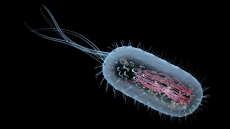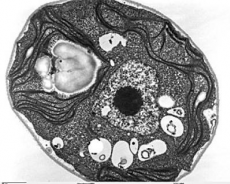

The average human body consists of 37.2 trillion cells, continuously going through the cycle of functioning, self-replication, and then death. Something so complex yet minuscule is truly fascinating and far more complex than what you may think. First to distinguish, there are two types of cells, prokaryotic and eukaryotic. Prokaryotic cells are single celled organisms, for example bacteria, whilst eukaryotic cells are larger and more complex. Inside all cells are smaller parts which help to carry out cell functioning, these are called organelles. Many are familiar with the infamous organelle called the nucleus (the control centre of the cell.) The human body is made out of eukaryotic. If we were to compare the two, the eukaryotic cell can be roughly 50 times larger, so we are dealing with extremely small quantities.
Prokaryotic cells contain circular deoxyribonucleic acid (DNA), free to float inside the cytoplasm. The cell is surrounded by a double membrane, this controls what can enter and leave the cell. There is also a cell wall, this provides strength and support. Now the prokaryotic cells are rather boring in comparison, as they only contain a few organelles like small ribosomes and no membrane bound organelles such as mitochondria (the powerhouse of eukaryotic cells.) Sometimes they may have a tail called flagella, made of the protein flagellin which is arranged in a helix. Simply put, prokaryotic cells live rather boring lives that are very short. This does however make them useful for laboratory experiments and industrial use. For example, did you know that a form of lactic acid bacteria can be grown to produce cheese and yoghurt?

Now onto the eukaryotic cells, like plant and animal cells. With more organelles and varying structures, eukaryotic cells can do more than you can imagine. In the earlier stages of the life cycle they possess a similar structure before undergoing differentiation where they go on to becoming specialised. So picture a very simple cell, which then divides continuously creating millions of copies. Some can become red blood cells, some pancreatic cells or perhaps a liver cell (hepatocyte.) An easy way to identify between a plant and an animal cell is to look and see if you can see a cell wall, if yes, then you are looking at a plant cell. You might also spot small organelles inside, which has connecting stacks of membrane, this is a chloroplast (also showing it is a plant cell.) Depending on the magnification and resolution will determine how easy it is to interpret a microscope image. Sometimes coloured dyes can be added to make features more visible.
Organelles which can be found in eukaryotic cells are: cell surface membrane, cell wall, nucleus, lysosome, ribosome, rough endoplasmic reticulum, smooth endoplasmic reticulum, vesicles, golgi apparatus, mitochondria, chloroplasts, centrioles, cilia, flagellum and many more. Organelles can be made from proteins, lipids or carbohydrates. At first when glancing at a diagram, it may look like a load of random shapes inside one big shape, but gradually, you can begin to identify specific features which make the the organelles recognisable.

0 Comment:
Be the first one to comment on this article.